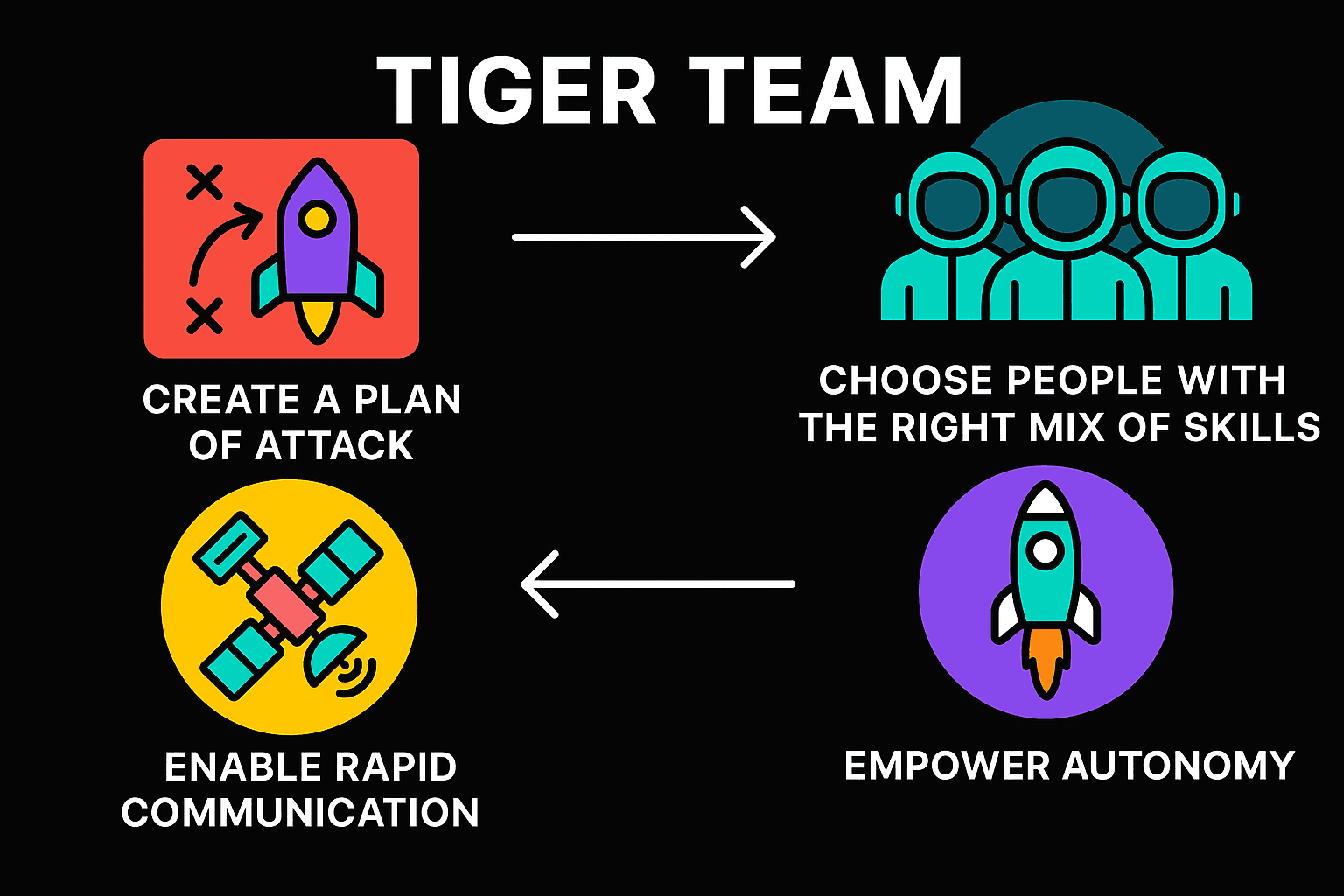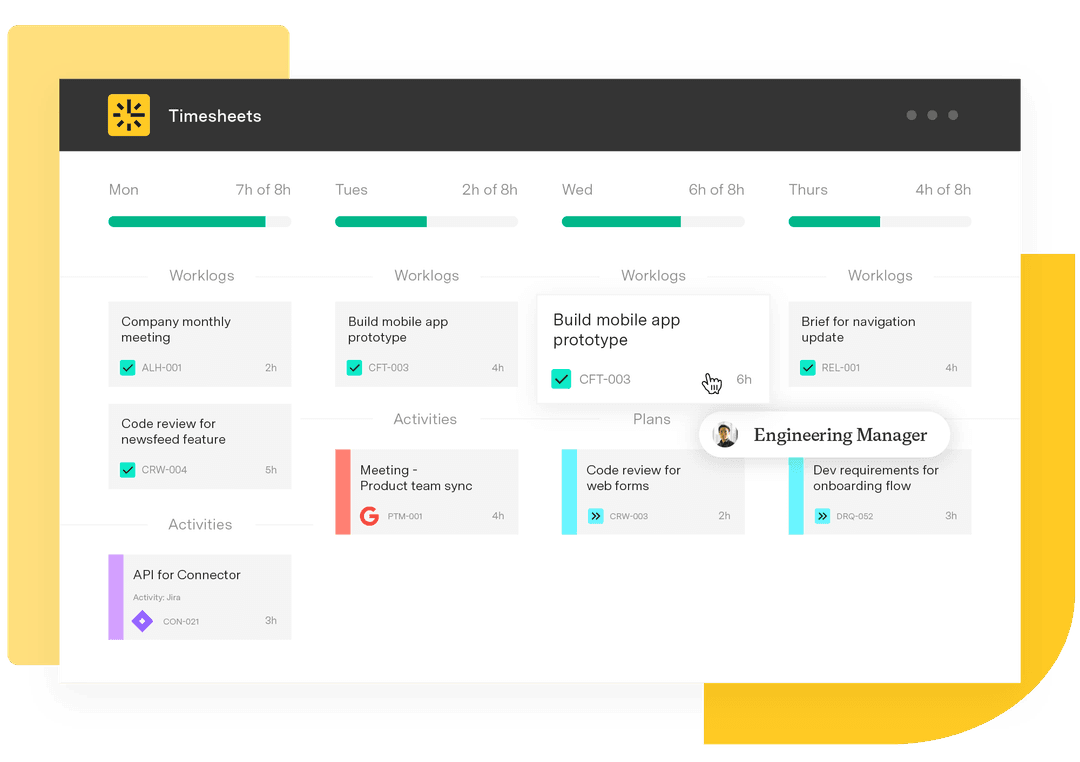Tiger teams: What they are and when to use them
Tempo Team
In business, some problems are too urgent or sensitive for the typical chain of command. That’s when many organizations call in a small, expert task force: a tiger team. Swift and laser-focused, its job is to deliver the best results in the shortest time possible.
In this guide, we’ll explain what a tiger team is in business, how it works, and when to use one. We’ll also highlight how Tempo helps you build a winning tiger team with the best people from across your org.
What’s a tiger team?
A tiger team is a small group of cross-functional specialists that tackles high-stakes, time-sensitive problems. Task-oriented and outcome-driven, they form quickly and operate with minimal oversight. And they usually disband once they’ve completed their mission.
The tiger team origin story begins with NASA’s Apollo 13 mission in 1970. After an oxygen tank exploded mid-flight, mission control quickly assembled a group of top engineers to troubleshoot the crisis from the ground. The team worked around the clock to design and test a solution using only the materials onboard – and ultimately guided the astronauts back to Earth safely. Their fast, focused collaboration under pressure saved lives, and it cemented the tiger team model as a go-to approach for rapid problem-solving in fields like technology, defense, healthcare, and business.

Today, many organizations deploy tiger teams to take on challenges that require extensive expertise and fast execution. Depending on the situation, they may operate for days, weeks, or months, but their purpose is always the same: To solve the problem as efficiently as possible.
When should you use a tiger team?
Tiger teams shine in moments that demand urgency and precision, when their specialized knowledge matters more than anyone else’s. Here are some common scenarios where organizations might use tiger teams:
Urgent system failures
It could be a payment portal crashing during a holiday sale or a new app release bricking user logins. When systems go down or run amok, every second counts. Instead of assigning scattered ownership across departments, a tiger team of engineers, QA leads, and project managers can isolate the problem to fix it and restore service with minimal delay.
Strategic changes
When companies enter a new market or shift strategy, decisions need input from every affected team. That means coordinating across pricing, compliance, operations, and beyond. A tiger team of experts – from product, finance, legal, and ops – can assess factors like local regulations and customer demand and flag potential risks early. With their niche expertise, they can map a clear path forward. Alignment happens faster, and surprises are minimal.
Product launches
Tight launch timelines or releases with a lot of customer visibility leave no room for last-minute delays. Even minor setbacks can lead to lost revenue or reputational damage. A tiger team of engineers, product managers, QA leads, and marketers can align quickly and resolve late-game roadblocks – without multi-team handoffs slowing them down.
Security and compliance threats
The longer issues like data breaches and audit findings linger, the greater the risk of legal trouble and regulatory penalties. Standard review processes often involve lengthy documentation and back-and-forth approvals from various departments. But a tiger team can analyze and remedy the situation and implement long-term safeguards to prevent it from happening again.
Customer escalations
Clients expect perfection, but mishaps like failed integrations or missed deliverables are sometimes unavoidable. When problems arise, a tiger team can step in with fast, specialized support to remedy the problem. That kind of service shows customers they’re a priority, which ultimately helps protect your brand reputation and long-term partnerships.
Stalled projects
When a project falls behind or hits a roadblock, a tiger team can serve as a catalyst for rebuilding momentum. It can assess what’s holding it back and drive it to completion. Other common scenarios include improving workflows or recovering from failed initiatives. With the right mix of expertise, tiger teams can deliver rapid results even under pressure.
Tiger team best practices
Winning tiger teams don’t come together by chance – they take careful planning and intention. While the structure is agile, the following best practices set them up for success:
1. Create a plan of attack
Before forming the team, think specifically about what success looks like and the steps to get there. Define the problem, and outline desired outcomes. Also think about constraints like timelines or limited resources. The more fine-tuned the plan, the better aligned everyone will be.
2. Choose people with the right mix of skills
Tiger teams need more than just people from different departments – they need experts who know their stuff and can make decisions quickly. Pick team members who can apply their knowledge under pressure and collaborate effectively. A mix of personality types creates a more balanced, better-functioning team, so aim for a blend of technical specialists, strategic thinkers, and decision-makers relevant to the challenge.
3. Enable rapid communication
Tiger teams work best when everyone’s in sync, so equip them with tools to communicate and share updates, like Slack channels or Jira boards. Also, encourage daily touchbases to give the team regular face time, which is never a bad thing when it comes to collaboration.
4. Empower autonomy
You’ve assembled top talent for a reason – now it’s time to trust them to deliver. Give them the leeway to bypass unnecessary approvals and red tape that might slow them down. Leaders should check in regularly, but autonomy is what allows tiger teams to solve problems with speed.
Benefits of tiger teams
When deployed effectively, tiger teams deliver a range of valuable benefits:
Accelerated problem-solving: Focused and empowered, tiger teams often resolve issues faster than traditional structures. With fewer handoffs and less bureaucracy, they’re able to make progress quickly.
Better cross-departmental collaboration: Tiger teams bring together the best representatives from different departments to achieve a shared goal. This strengthens team relationships and encourages collaboration well beyond the immediate project.
Shorter downtime: With clear ownership over fixing failures and mitigating risks, tiger teams help resolve major issues in record time, which minimizes disruption across the business.
More innovative solutions: When specialists from diverse disciplines work side by side on a tiger team, they often produce creative solutions that siloed teams might miss. This also builds trust and strengthens teamwork across the organization.
More focus and ownership: The temporary nature of tiger teams creates urgency. Everyone knows the stakes are high and the clock’s running. Concrete, time-bound goals keep members engaged and committed to delivering results.
Lasting impact: Once a tiger team wraps, their work often lives on through documented findings and improved processes. This helps organizations avoid similar issues in the future.
Optimize team performance with Tempo
Assembling the right group of people is only half the battle for tiger teams. They also need tools that support visibility, coordination, and follow-through – like Tempo’s Jira-native solutions.
Timesheets track team efforts in real time, making it easy to see how much work is going into resolving an issue. That kind of visibility helps prevent burnout and keeps teams on track for peak performance.
With Capacity Planner, you can quickly assess staff availability and assign the right mix of team members without derailing other priorities. Model workloads, test different scenarios, and move forward knowing your tiger team has the bandwidth to get the job done.
From team formation to follow-through, Tempo enables tiger teams to do their best work. Try it today.











































